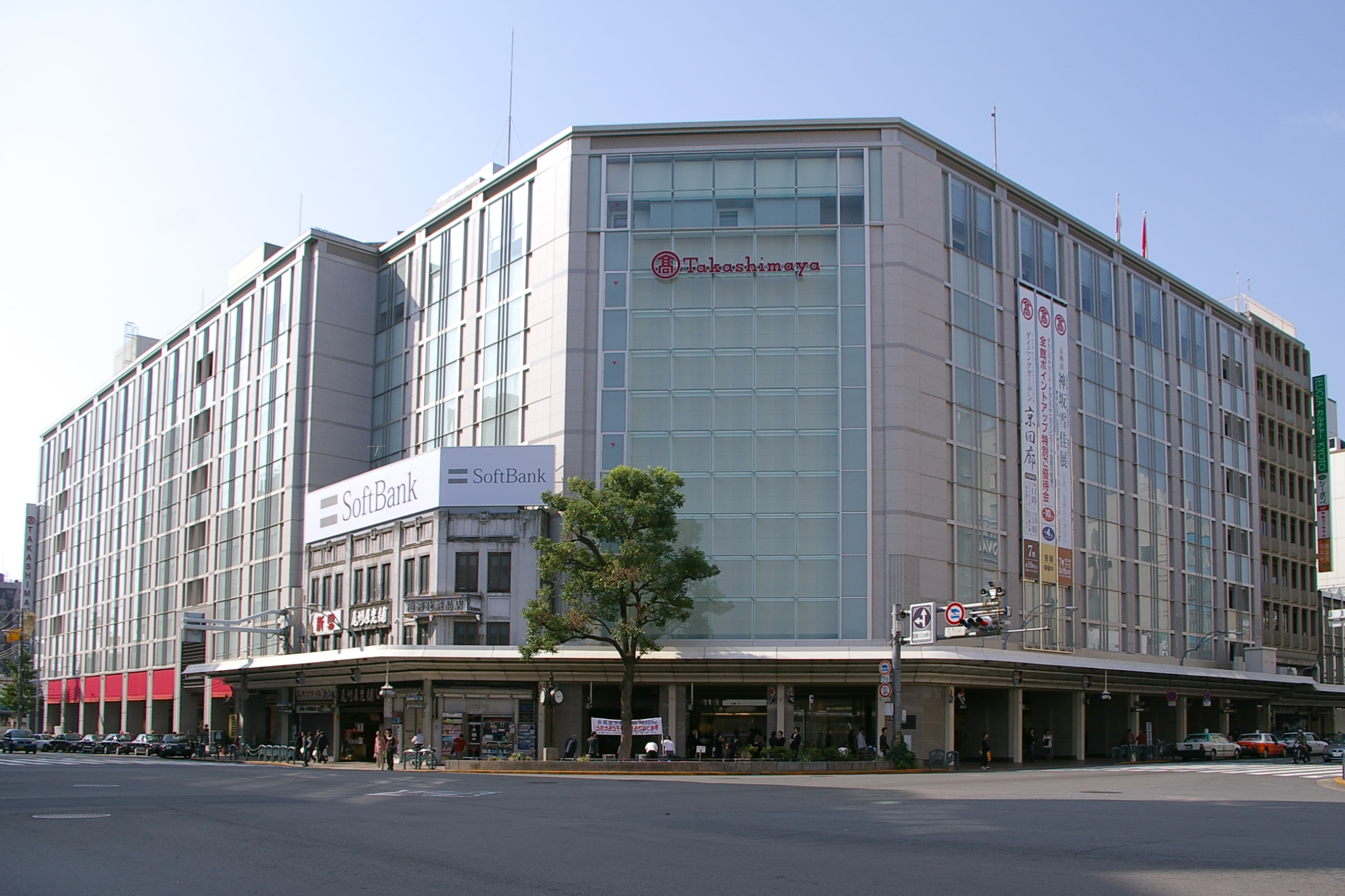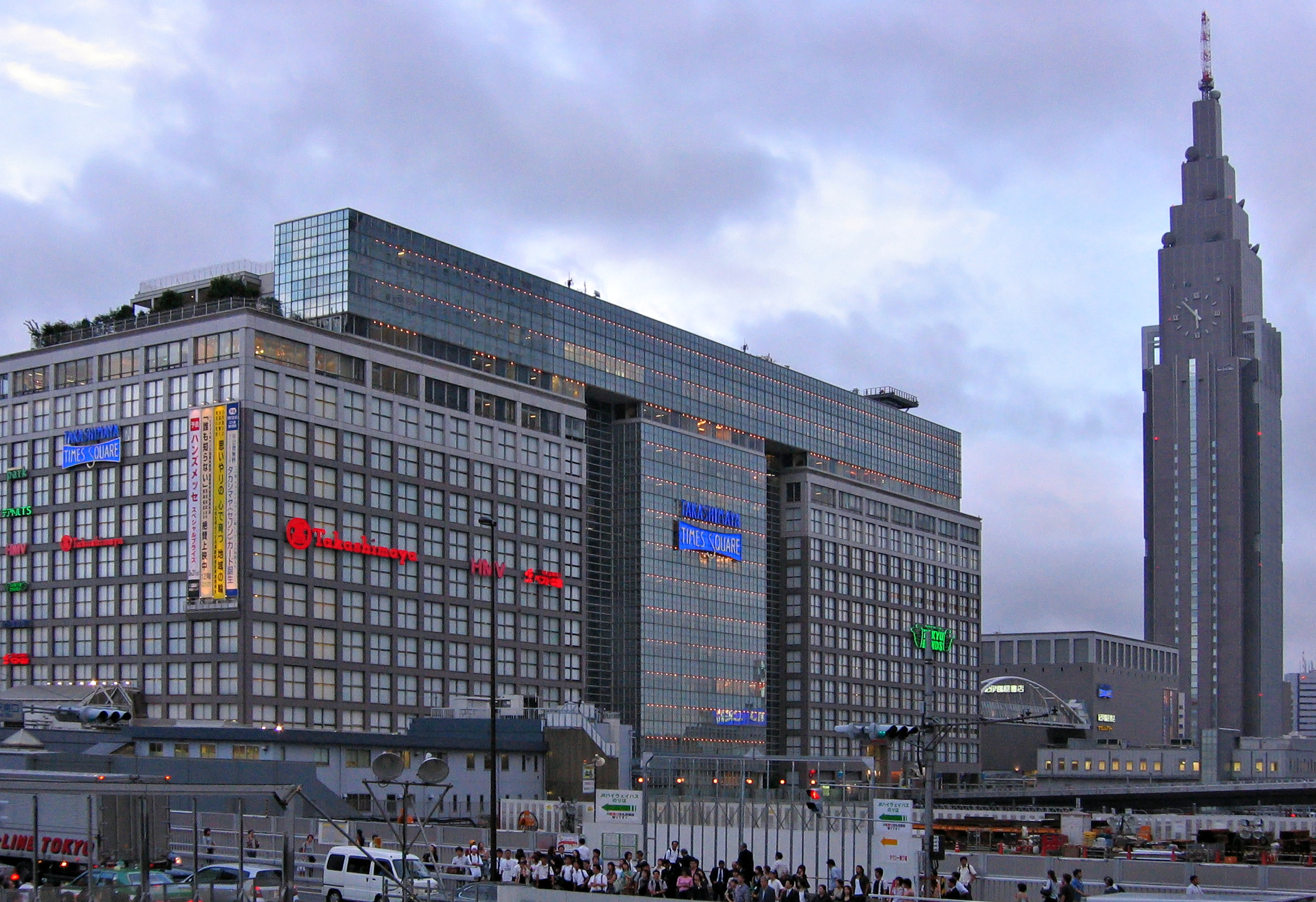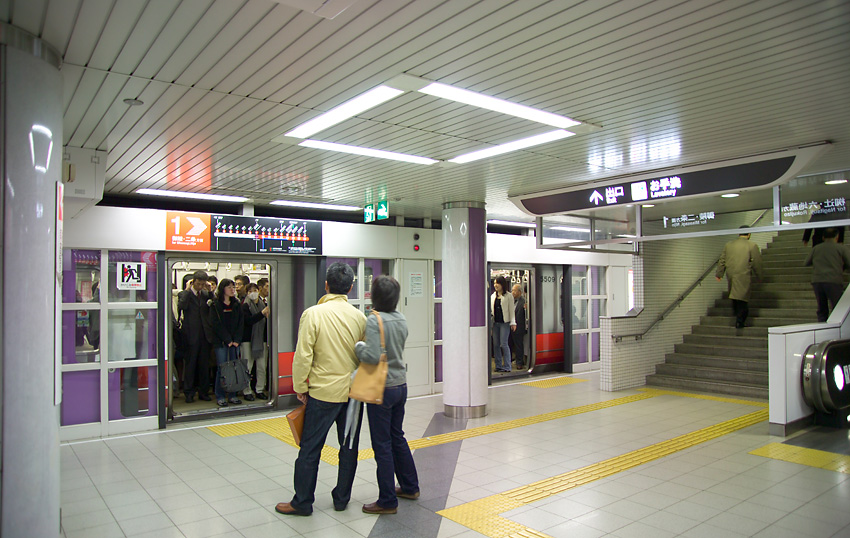|
Kawaramachi
runs parallel to the west bank of the Kamo River on the eastern side of Kyoto, Japan. Its intersection with Shijō Street is called Shijō Kawaramachi and is a leading shopping district of the city. Both Shijō and Kawaramachi Street are protected with smoking bans. Overview Edo Period Located outside of Heian-kyō and runs almost parallel to Toyotomi Hideyoshi's Odoi. It is thought that it was established when the city expanded to the Kamo River in the early Edo Period. From north to south it extends from Aoibashi Nishizume to Jujō Street. North of Aoibashi Nishizume its name changes to Shimogamo Main Street. South of Jujō Street it curves along the Kamo River and joins with Kuzebashi Street. The stretch between Sanjō Street and Shijō Street is one of Kyoto's downtown shopping streets. Because the portion between Shijō Street and Kamijuzuyacho Street runs parallel to the Kamo River bending in a North-North-East and South-South-West direction it naturally interse ... [...More Info...] [...Related Items...] OR: [Wikipedia] [Google] [Baidu] |
Shijō Kawaramachi
is a vibrant part of central Kyoto, Japan where Shijō Street, Shijō and Kawaramachi Streets intersect. Kawaramachi Street runs parallel to the Kamo River on the eastern side of Kyoto, while Shijō Street runs east–west through the center of the city. Stores Two of four corners of the intersection are occupied by department stores: Takashimaya at the southwest corner and Kyoto Marui at the southeast corner. Kyoto Marui opened on April 27, 2011 replacing Hankyu Department Store, which closed on August 22, 2010. Railway station Kyoto-kawaramachi Station is the terminal of the Hankyu Kyoto Line (Hankyu Railway) in Kyoto. The underground station lies beneath the Shijō Kawaramachi intersection. Passengers may change trains from Kyoto-kawaramachi Station to Gion-Shijō Station (Keihan Railway Keihan Main Line), which is located beyond the Kamo River. The real estate around Kawaramachi station at one time ranked among the most valuable in Japan before the Japanese asset price bub ... [...More Info...] [...Related Items...] OR: [Wikipedia] [Google] [Baidu] |
Kyoto-kawaramachi Station
is the northern terminal station of the Hankyu Kyoto Main Line of Hankyu in Kyoto City, Japan. Layout The station has an island platform serving three tracks underground. Adjacent stations History This station opened as Kawaramachi Station on June 17, 1963; it was renamed to Kyoto-kawaramachi Station on October 1, 2019. Before the opening of Kawaramachi Station and Karasuma Station, the Hankyu Kyoto Main Line terminated at Ōmiya Station. Station numbering was introduced to all Hankyu stations on 21 December 2013 with this station being designated as station number HK-86. Passenger statistics In fiscal 2015 (April 2015 to March 2016), approximately 27,320,000 passengers used this station annually. For historical data, see the table below. Surrounding area The area around the station (Shijō Kawaramachi) is one of the commercial centers of Kyoto. The real estate around the station is the most valuable in Kyoto. The Kawaramachi and Shijo streets cross over ... [...More Info...] [...Related Items...] OR: [Wikipedia] [Google] [Baidu] |
Takashimaya
is a Japanese multinational corporation operating a department store chain carrying a wide array of products, ranging from wedding dresses and other apparel to electronics and flatware. It has more than 12 branches strategically located in 2 regions, and 4 international branches around Asia. Takashimaya has been a member of the International Association of Department Stores from 1962 to 1997. Takashimaya was listed at #1197 on the Forbes Global 2000 list for 2006. Takashimaya is a member of the Sanwa Group keiretsu. History The first Takashimaya store was opened in Kyoto in 1831 as a sole proprietorship owned by Shinshichi Iida, a merchant from present-day Fukui Prefecture. The original store in Kyoto was only 3.6 square meters in area and specialized in selling gofuku (formal kimono). A second Kyoto store opened in 1893, followed by a Tokyo store in 1897 and an Osaka store in 1898. Takashimaya was incorporated as a gomei kaisha (unlimited liability company) in 1909 ... [...More Info...] [...Related Items...] OR: [Wikipedia] [Google] [Baidu] |
Kyoto Shiyakusho-mae Station
Kyoto Shiyakusho-mae Station (京都市役所前駅 ''Kyōto shiyakusho-mae eki'') is a stop on the Tozai Line of Kyoto Municipal Subway in Kyoto, Japan. It is in Nakagyo-ku. With the station number designation T12, its station color is ''kara kurenai''. Because it lies beneath the Kawaramachi-Oike intersection, the station also carries signs with the name ''Kawaramachi Oike''. The station has one island platform serving two tracks. Most trains of the Keihan Railway Keishin Line make their last stop at Kyoto Shiyakusho-mae before reversing direction. The station, the name of which means "in front of City Hall," is the closest to the offices of Kyoto's city government. The Honnō-ji was rebuilt nearby, rather than at its original location, following the Incident at Honnōji. Also in the vicinity is the Kyoto office of the Bank of Japan. History The Kyoto Shiyakusho-mae Station opened on October 12, 1997, date when the Tōzai line initiated operations between Daigo Station a ... [...More Info...] [...Related Items...] OR: [Wikipedia] [Google] [Baidu] |
Hankyu Kyoto Main Line
The is a railway line in Japan operated by the private railway operator Hankyu Railway. It connects Osaka-umeda Station in Osaka and Kyoto-kawaramachi Station in Kyoto. Definition The Kyoto Main Line is often called the for short, and in a broader sense its two branch lines, the Senri Line and the Arashiyama Line, are included to the Kyoto Line by historical, geographical and structural reasons. The other two sections of Hankyu, the Kobe Line and the Takarazuka Line are called the as a whole. Officially, the Kyoto Main Line is from Jūsō to Kyoto-kawaramachi, however, all trains run beyond Jūsō to Osaka-umeda terminal, using the eastern tracks of the section exclusively. Hankyu treats the Kyoto Main Line in the same way as the passengers do, i.e. as the line between Osaka-umeda and Kyoto-kawaramachi (except for special circumstances such as governmental procedures). History The Kyoto Main Line was constructed in the following phases: * 1 April 1, 1921: Jūsō – Awaji ... [...More Info...] [...Related Items...] OR: [Wikipedia] [Google] [Baidu] |
Hankyu
, trading as , is a Japanese private railway company that provides commuter and interurban service to the northern Kansai region and is one of the flagship properties of Hankyu Hanshin Holdings Inc., in turn part of the Hankyu Hanshin Toho Group (which includes H2O Retailing Corporation and Toho Co., the creator of ''Godzilla''). The railway's main terminal is at Umeda Station in Osaka. The signature color of Hankyu cars is maroon. The Hankyu network serves 1,950,000 people every weekday and offers several types of express service with no extra charge. The head offices of Hankyu Hanshin Holdings, Inc. and Hankyu Corporation are at 1-16-1, Shibata, Kita-ku, Osaka; the both companies' registered headquarters are at 1-1, Sakaemachi, Ikeda, Osaka Prefecture. The Takarazuka Revue, an all-female musical theatre performance company, is well known as a division of the Hankyu railway company; all of its members are employed by Hankyu. History Etymology The name is an abbreviation ... [...More Info...] [...Related Items...] OR: [Wikipedia] [Google] [Baidu] |
Kyoto Gion Matsuri J09 151
Kyoto (; Japanese: , ''Kyōto'' ), officially , is the capital city of Kyoto Prefecture in Japan. Located in the Kansai region on the island of Honshu, Kyoto forms a part of the Keihanshin metropolitan area along with Osaka and Kobe. , the city had a population of 1.46 million. The city is the cultural anchor of a substantially larger metropolitan area known as Greater Kyoto, a metropolitan statistical area (MSA) home to a census-estimated 3.8 million people. Kyoto is one of the oldest municipalities in Japan, having been chosen in 794 as the new seat of Japan's imperial court by Emperor Kanmu. The original city, named Heian-kyō, was arranged in accordance with traditional Chinese feng shui following the model of the ancient Chinese capital of Chang'an/Luoyang. The emperors of Japan ruled from Kyoto in the following eleven centuries until 1869. It was the scene of several key events of the Muromachi period, Sengoku period, and the Boshin War, such as the Ōnin War, the Honn� ... [...More Info...] [...Related Items...] OR: [Wikipedia] [Google] [Baidu] |
Tōzai Line (Kyoto)
The is a Kyoto Municipal Subway line which runs from the southeastern area of the city (starting from Rokujizo Station), then east to west (i.e. ''tōzai'' in Japanese) through the Kyoto downtown area. The Kyoto Municipal Transportation Bureau operates the system along with the Karasuma Line and the City Bus. The present terminal stations are Rokujizo Station in Uji and Uzumasa Tenjingawa Station in Ukyō-ku, Kyoto. It handles an average of 241,133 passengers daily (2009 data). The stations are wheelchair-friendly, with elevators, narrow gaps between platform and train, and no height differences at places like restrooms. Each station has a colour code for easy recognition. All platforms on the line are island platforms, and have platform screen doors separating the platform from the tracks. The line is 17.5 km long with a track gauge of . The entire length is double-track. Trains are electric, operating on 1,500 V DC. Trains travel between Rokujizō and Uzumasa Ten ... [...More Info...] [...Related Items...] OR: [Wikipedia] [Google] [Baidu] |
Kyoto Prefectural University Of Medicine
is a public university in Kyoto, Kyoto, Japan. The school's predecessor was founded in 1872, and it was chartered as a university in 1921. KPUM differs from Kyoto University, or "Kyodai" which is located nearby across the Kamo River, in that Kyoto University was nationally incorporated in 2004, and as such falls partly under the control of the Japanese Ministry of Education(文部科学省 Monbu-kagaku-shō). Kyoto Prefectural University of Medicine declined to become nationally incorporated in order to retain a degree of academic freedom and independence. A major difference between the two schools can be described in terms of specialization. KPUM has medicine as its primary focus, whereas Kyodai concentrates on providing recruits for corporate Japan. Both schools pursue a shared passion for a recently developed concept known as "Gurobaru Jinzai Ikusei", reaching past borders for Japan's future success. Kyoto Prefectural University of Medicine Hospital (京都府立医科大学附 ... [...More Info...] [...Related Items...] OR: [Wikipedia] [Google] [Baidu] |
Kyoto
Kyoto (; Japanese: , ''Kyōto'' ), officially , is the capital city of Kyoto Prefecture in Japan. Located in the Kansai region on the island of Honshu, Kyoto forms a part of the Keihanshin metropolitan area along with Osaka and Kobe. , the city had a population of 1.46 million. The city is the cultural anchor of a substantially larger metropolitan area known as Greater Kyoto, a metropolitan statistical area (MSA) home to a census-estimated 3.8 million people. Kyoto is one of the oldest municipalities in Japan, having been chosen in 794 as the new seat of Japan's imperial court by Emperor Kanmu. The original city, named Heian-kyō, was arranged in accordance with traditional Chinese feng shui following the model of the ancient Chinese capital of Chang'an/ Luoyang. The emperors of Japan ruled from Kyoto in the following eleven centuries until 1869. It was the scene of several key events of the Muromachi period, Sengoku period, and the Boshin War, such as the Ōnin War, ... [...More Info...] [...Related Items...] OR: [Wikipedia] [Google] [Baidu] |
Kitamura Museum
opened near the confluence of the Kamo and Takano Rivers in Kyoto, Japan, in 1977. The collection, based on that built up by businessman , comprises some 1,000 works including thirty-three Important Cultural Properties and nine Important Art Objects, with a particular focus on tea utensils. There is also a tea garden, , a Registered Cultural Property. The Museum opens to the public for exhibitions each autumn and spring. Important Cultural Properties Among the Museum's thirty-three Important Cultural Properties are the pair of scrolls ''Kite and Crows'' by Yosa Buson, Fujiwara no Nakafumi, from the series Thirty-Six Poetry Immortals formerly in the Satake Collection, and the Spring 1227 (Karoku 3) portion of Fujiwara no Teika's . Image:Kite and Crows by Yosa Buson (Kitamura Museum)R.jpg, ''Kite'', from ''Kite and Crows'', by Yosa Buson Image:Kite and Crows by Buson (Kitamura Museum)L.jpg, ''Crows'', from ''Kite and Crows'', by Yosa Buson Image:Fujiwara no Nakafumi (Kitamu ... [...More Info...] [...Related Items...] OR: [Wikipedia] [Google] [Baidu] |
Honzen-ji
is a Buddhist temple in Kyoto Kyoto (; Japanese: , ''Kyōto'' ), officially , is the capital city of Kyoto Prefecture in Japan. Located in the Kansai region on the island of Honshu, Kyoto forms a part of the Keihanshin metropolitan area along with Osaka and Kobe. , the ci .... Buddhist temples in Kyoto {{Japan-reli-stub ... [...More Info...] [...Related Items...] OR: [Wikipedia] [Google] [Baidu] |







